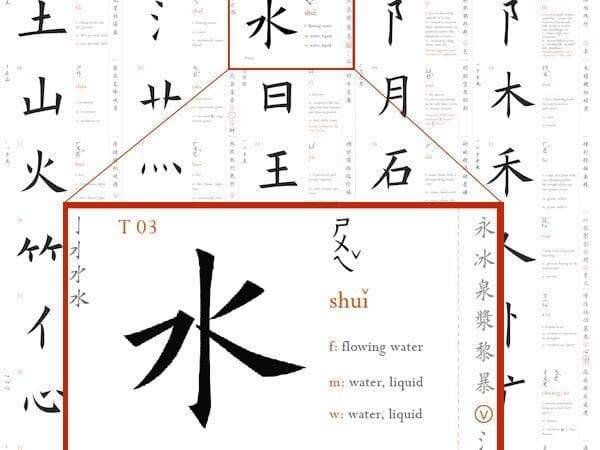How to Master the Dreaded Chinese Characters
In my beginner courses I usually don’t like focusing too much on Chinese characters, because they’re a lot of work and spending excessive time on them at the beginning can distract from the goal of trying to learn the spoken language, which is quite a challenging task in and of itself. (Although read this on why Chinese is actually easier to learn than you think!)
Not to scare you too much, but learning the characters well is a massive amount of work totally separate from the work you need to put in to learn the spoken language. The reason is that, unlike languages like English where you spell out what you want to say phonetically with an alphabet, in Chinese you write with unique symbols, or characters, for each word that basically must be individually memorized. Now many symbols do get reused in different words, and characters do contain shared components that somewhat simplifies the learning process, but there’s no getting around the fact that in order to be able to comfortably read Chinese you’ll need to have the ability to passively recognize thousands of unique characters. Yikes.
But here’s the thing: it’s all worth it. First of all, because Chinese characters are just freakin’ cool. They’re an amazingly beautiful yet powerfully expressive form of writing that for thousands of years served as the lingua franca of Asia — because of their unique properties, Chinese characters have been used to write Japanese, Korean, and Vietnamese, not to mention the hundreds of local Chinese dialects within China. And they contain so much interesting history and culture embedded within them. For instance, the character 麻 is a representation of hemp plants 𣏟 drying on a cliff 厂. It’s used to write the word “numb,” indicating to even a casual observer that the ancient Chinese were aware of the medicinal value of marijuana. (This is supported by other historical evidence as well.)
But more importantly, you should learn Chinese characters because any Chinese person will tell you that you can’t truly understand the Chinese language without understanding Chinese characters. Yes, Chinese people will be amazed if you can speak fluent Chinese, but their follow-up question will inevitably be 你会写吗, “can you write?” And if you can, that’s the clincher. The vast majority of Chinese people do not and cannot read or write in pīnyīn, the Chinese alphabet used to teach Chinese to children and foreigners, so to be literate in Chinese and earn the true respect of the Chinese people you’ll have to learn the characters.
So where do you start? You could cobble together some material online and do it yourself, but it’s better to have a systematic approach. Here are some of my recommendations! (I don’t have business relationships with any of these companies.)
Skritter
This is a powerful app designed specifically to help you learn to write Chinese characters. You get to practice tracing characters in-app with real-time feedback, and it includes tone support and character composition to help you remember the meaning behind the character. It can be somewhat overkill, especially if you don’t feel the need to perfect your handwriting (I never did), but it’s the gold standard for learning characters.
$14.99/month, skritter.com
Remembr.it teaches you Chinese characters in a really smart way — by focusing on characters that share phonetic components. It’s a very good idea to learn like this because it helps you understand the logic behind the characters and also helps ensure you won’t confuse characters that look similar. They also have a nice flashcard-based review system built right in. Unlike Skritter there’s less of a focus on handwriting here, so definitely recommended if you’re more interested in recognizing than writing (like me!).
$12/month, remembr.it
Anki is the best way to memorize stuff, period. It’s essentially just a really well-made free flashcard program and app where you can create your own cards or download premade decks (including plenty on Chinese characters).
Reviews are optimally spaced by
a hyper-efficient algorithm, ensuring that you won’t forget what you learn while minimizing your study time. I wouldn’t recommend trying to learn characters via Anki if you’re brand new to Chinese, but if you have some experience under your belt Anki is a great way to boost your knowledge and retain what you learn.
Free, ankiweb.net
I’ll be honest — I haven’t taken this course. But I can guarantee you it’s good because this company is backed by a team of Chinese literature PhDs who have created the best explanatory dictionary of Chinese characters currently available in English (and my personal favorite). They really understand Chinese characters and by the end of this course you probably will, too. A word of caution: they tend to go deep, so I wouldn’t recommend this course unless you’re really interested in nerding out over Chinese characters. It’s also less of a “Chinese characters” course and more of a “learn how to learn Chinese characters” course, so take that for what it’s worth.
$99, outlier-linguistics.com
James Heisig pioneered this popular method of learning Japanese and Chinese characters by remembering stories associated with characters’ structures back in the 1970s, and his method inspires a lot of passion to this day but also a lot of skepticism. On the one hand it’s a novel way to rapidly learn the meaning behind hundreds of characters, on the other it’s not particularly traditional and you don’t learn pronunciation. This one’s a love it or hate it!
$29, amazon.com (comes in traditional or simplified)




